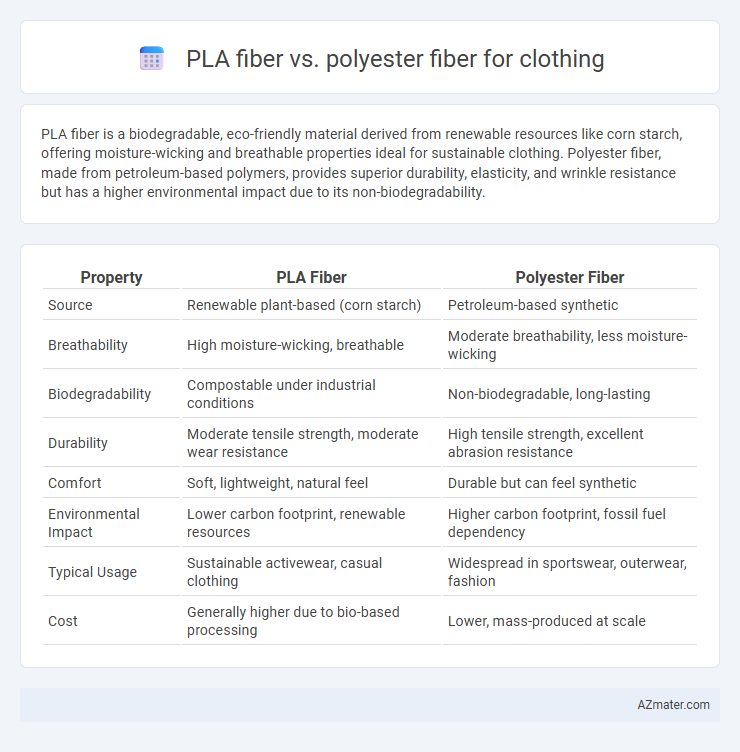PLA fiber is a biodegradable, eco-friendly material derived from renewable resources like corn starch, offering moisture-wicking and breathable properties ideal for sustainable clothing. Polyester fiber, made from petroleum-based polymers, provides superior durability, elasticity, and wrinkle resistance but has a higher environmental impact due to its non-biodegradability.
Table of Comparison
| Property | PLA Fiber | Polyester Fiber |
|---|---|---|
| Source | Renewable plant-based (corn starch) | Petroleum-based synthetic |
| Breathability | High moisture-wicking, breathable | Moderate breathability, less moisture-wicking |
| Biodegradability | Compostable under industrial conditions | Non-biodegradable, long-lasting |
| Durability | Moderate tensile strength, moderate wear resistance | High tensile strength, excellent abrasion resistance |
| Comfort | Soft, lightweight, natural feel | Durable but can feel synthetic |
| Environmental Impact | Lower carbon footprint, renewable resources | Higher carbon footprint, fossil fuel dependency |
| Typical Usage | Sustainable activewear, casual clothing | Widespread in sportswear, outerwear, fashion |
| Cost | Generally higher due to bio-based processing | Lower, mass-produced at scale |
Introduction to PLA and Polyester Fibers
PLA fiber, derived from renewable resources like cornstarch, offers biodegradability and breathability, making it an eco-friendly alternative in clothing. Polyester fiber, a synthetic polymer made from petroleum-based products, is known for its durability, moisture-wicking properties, and resistance to wrinkles and shrinking. Both fibers serve distinct purposes in textiles, with PLA emphasizing sustainability and comfort, while polyester prioritizes performance and longevity.
Composition and Origin of PLA and Polyester
PLA fiber is derived from renewable resources such as corn starch or sugarcane through a fermentation process, making it a biodegradable and environmentally friendly option for clothing. Polyester fiber, on the other hand, is a synthetic material produced from petroleum-based polymers, primarily polyethylene terephthalate (PET), resulting in durability and resistance to shrinking and stretching. The natural origin of PLA contrasts with the petrochemical origin of polyester, influencing their sustainability profiles and end-of-life biodegradability in textile applications.
Manufacturing Processes Compared
PLA fiber is derived from renewable resources such as corn starch through a fermentation process followed by polymerization and extrusion, making it more environmentally friendly compared to polyester fiber, which is produced from petrochemical raw materials via polymerization of purified terephthalic acid (PTA) and monoethylene glycol (MEG). The manufacturing of PLA fiber involves lower energy consumption and emits fewer greenhouse gases, whereas polyester fiber production relies heavily on fossil fuels and generates higher carbon emissions. PLA's biodegradability contrasts with polyester's synthetic, non-biodegradable properties, influencing the overall sustainability and ecological footprint in clothing manufacturing.
Physical Properties and Performance
PLA fiber, derived from renewable resources like corn starch, exhibits excellent moisture-wicking properties and biodegradability, making it a sustainable choice for clothing. Polyester fiber offers superior strength, durability, and wrinkle resistance, maintaining its shape and color after multiple washes. Both fibers provide thermal insulation, but PLA is more breathable while polyester excels in elasticity and UV resistance.
Comfort and Breathability in Clothing
PLA fiber, derived from renewable plant sources like corn starch, offers superior moisture-wicking properties and excellent breathability, making it highly comfortable in warm climates. Polyester fiber, while durable and wrinkle-resistant, tends to trap heat and moisture, resulting in less breathability and potential discomfort during prolonged wear. The natural biodegradability and softness of PLA fiber enhance its comfort level compared to the synthetic texture of polyester.
Environmental Impact and Sustainability
PLA fiber, derived from renewable resources like corn starch, offers significant environmental benefits due to its biodegradability and lower carbon footprint compared to petroleum-based polyester fiber. Polyester fiber, while durable and widely used, relies on fossil fuels and contributes to microplastic pollution and higher greenhouse gas emissions during production and disposal. Choosing PLA fiber supports sustainability goals by reducing reliance on non-renewable resources and minimizing long-term environmental impact in the clothing industry.
Biodegradability and End-of-Life Options
PLA fiber, derived from renewable resources like corn starch, offers significant biodegradability advantages over traditional polyester fiber, which is petroleum-based and non-biodegradable. PLA fibers can decompose in industrial composting conditions within months, reducing landfill accumulation and microplastic pollution, whereas polyester persists for decades, contributing to environmental harm. End-of-life options for PLA include composting and recycling, while polyester primarily relies on mechanical recycling or energy recovery, making PLA a more sustainable choice for eco-friendly clothing.
Cost and Market Availability
PLA fiber, derived from renewable resources like corn starch, generally costs more than polyester fiber due to its bio-based production process and lower economies of scale. Polyester fiber dominates the market with widespread availability and lower production costs, making it the preferred choice for mass-produced clothing. However, increasing demand for sustainable textiles is gradually improving PLA fiber market accessibility, influencing pricing dynamics.
Applications in Fashion and Apparel Design
PLA fiber offers biodegradable and sustainable alternatives ideal for eco-conscious fashion, providing moisture-wicking and UV resistance properties suitable for activewear and casual apparel. Polyester fiber excels in durability, elasticity, and color retention, making it a preferred choice for performance garments, outerwear, and fast-fashion items. Designers often blend PLA with polyester to enhance fabric functionality, combining sustainability with cost-effective production in contemporary apparel collections.
Future Trends in Textile Fiber Innovation
PLA fiber, derived from renewable corn starch, offers biodegradable and sustainable alternatives to conventional polyester fiber, aligning with increasing consumer demand for eco-friendly clothing. Innovations in PLA fiber enhance its mechanical strength and moisture-wicking properties, making it more competitive with polyester's durability and versatility in textile applications. Future trends emphasize blending PLA with recycled polyester to balance performance, sustainability, and cost-effectiveness in next-generation textile fibers.

Infographic: PLA fiber vs Polyester fiber for Clothing
 azmater.com
azmater.com